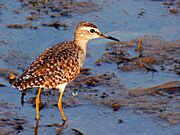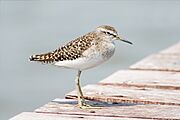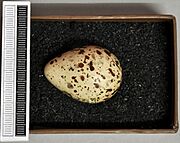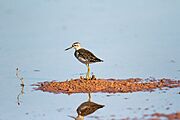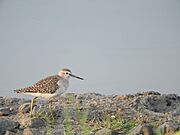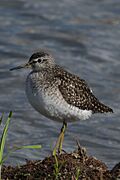Wood sandpiper facts for kids
The wood sandpiper (Tringa glareola) is a small wading bird. It's known for its long legs and slender body. This bird lives across Europe and Asia and travels long distances to warmer places for winter. It's the smallest bird in a group called "shanks," which are medium-sized wading birds. The name Tringa comes from an old name for a similar bird, and glareola means "gravel" in Latin, probably because it likes gravelly areas.
Quick facts for kids Wood sandpiper |
|
|---|---|
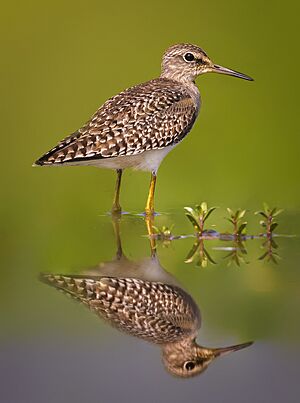 |
|
| Wood sandpiper in Bangabandhu Sheikh Mujib Safari Park, Gazipur City, Bangladesh | |
| Conservation status | |
| Scientific classification | |
| Genus: |
Tringa
|
| Species: |
glareola
|
| Synonyms | |
|
Rhyacophilus glareola (Linnaeus, 1758) |
|
What Does It Look Like?
The wood sandpiper looks a bit like a longer-legged, more delicate version of the Green sandpiper or solitary sandpiper. It has a short, thin bill, a brown back, and longer yellowish legs. You can tell it apart from the green sandpiper because its white rump (the area above its tail) is smaller and less noticeable. The solitary sandpiper doesn't have a white rump at all.
Even though it looks similar, the wood sandpiper is not very closely related to the green or solitary sandpipers. Instead, its closest relative is the common redshank. These two birds are also related to the marsh sandpiper. These three species are all smaller shanks with red or yellowish legs. When they are ready to breed, their feathers are usually light brown on top with some darker spots. They also have small brownish spots on their chest and neck.
Where Does It Live and What Does It Eat?
The wood sandpiper makes its nests in subarctic wet areas. These places are found from the Scottish Highlands across Europe and then east across Asia. When winter comes, these birds fly south. They travel to Africa, Southern Asia (especially India), and Australia. Sometimes, a few birds get lost and fly even further, reaching places like the Hawaiian Islands in the Pacific. In areas like the Mariana Islands and Palau, they visit regularly. They are usually seen in the western Pacific between mid-October and mid-May. Since the 1950s, a small group of wood sandpipers has also started breeding in Scotland.
These birds usually stay near freshwater during their long trips and in winter. They look for food by poking their bills in shallow water or wet mud. They mostly eat insects and other small creatures.
Life Cycle and Migration
Wood sandpipers build their nests on the ground. Sometimes, they use an old nest left by another bird, like a fieldfare. Between March and May, the female wood sandpiper lays four pale green eggs.
Adult wood sandpipers change all their main flight feathers between August and December. Younger birds change some of their outer flight feathers between December and April. Young birds are more flexible than adults about when and how fast they change their feathers and build up energy for their journeys. Both adult and young birds can store enough energy to fly very long distances without stopping. They can fly between 2,397 and 4,490 kilometers (about 1,490 to 2,790 miles) in one flight!
The wood sandpiper is a bird protected by an agreement called the Agreement on the Conservation of African-Eurasian Migratory Waterbirds (AEWA). This agreement helps protect birds that fly long distances between Africa, Europe, and Asia.
Because the wood sandpiper is found in many places, it is considered a species of Least Concern by the IUCN. This means it is not currently in danger of disappearing.
-
Wood sandpiper Mangaon, Maharashtra, India



